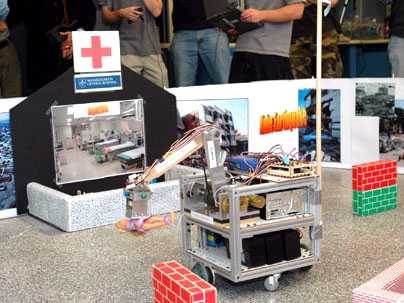Images of men, women and children stranded on rooftops or trapped amid mountains of rubble following natural disasters leave many with a sense of helplessness.
But those same images inspired the designers of mechanical engineering course 2.12 to apply robotics technology to disaster response and rescue missions.
Students in the course demonstrated their rescue robots on Wednesday, Dec. 14, in the d'Arbeloff Lab, Room 1-005.
Each 2.12 robot -- a hotel refrigerator-shaped platform guided by an onboard Linux computer -- had to navigate a space displaying photo images from Hurricane Katrina, the 2004 Southeast Indian tsunami and the 1995 Kobe earthquake in Japan. The robots had to locate three different long-haired dolls, pluck each from "her" individual catastrophe scene, carry her to an emergency room and drop her to safety.
Various sensors, including a laser range scanner, helped the 'bots locate their dolls -- a blonde, a brunette and a redhead -- all barefoot and dressed in casual summer clothes. A manipulator arm did the heavy lifting, aided by a large magnet attached to each doll's belly.
Eric Wade, teaching assistant for 2.12, noted that the rescue robots had to be able to distinguish houses from debris en route to locating casualties, and also that demos like Wednesday's offer built-in suspense.
"The students were responsible for the robot fabrication, and for writing the code that runs the robots. All tasks are preprogrammed into the robot, and have to be completed without any instruction from the builders," he said.
Harry Asada, professor of mechanical engineering, and John Leonard, associate professor of mechanical engineering, teach 2.12.
"These students stay up all night to get it right. They've had just five weeks to do this. If I could give them anything, it would be more time," Leonard said the day before the robots went live as rescue workers.
A version of this article appeared in MIT Tech Talk on December 21, 2005 (download PDF).






